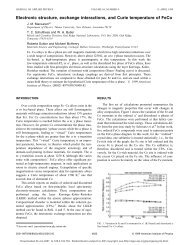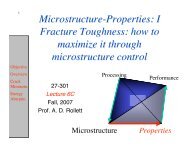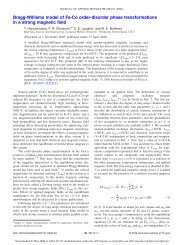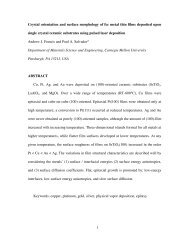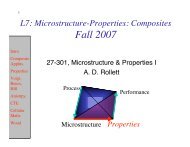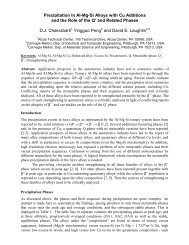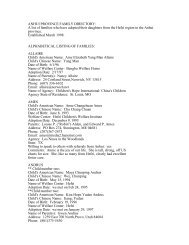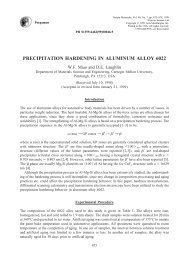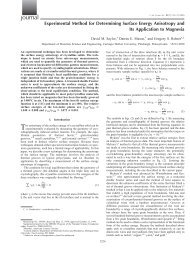popLA Manual (PDF) - Materials Science and Engineering
popLA Manual (PDF) - Materials Science and Engineering
popLA Manual (PDF) - Materials Science and Engineering
Create successful ePaper yourself
Turn your PDF publications into a flip-book with our unique Google optimized e-Paper software.
Copying the following files to the st<strong>and</strong>ard-name input files, for example, would provide a consistent set of<br />
input data for simulating a compression test on an initially isotropic material:<br />
Purpose SXIN PROPIN TEXIN BCIN<br />
predict texture in Cu SXCUB PROPCU TEXISO0.WTS BCCOM<br />
evaluate fcc slip systems SXFCC PROPFCC TEXISO0.WTS BCCOM<br />
A variety of additional input data are determined interactively during the run. Many of them are recorded in<br />
a "TTY interaction file" called POTTY. When a POTTY file exists, you will be asked whether to skip a whole<br />
raft of questions, in which case the existing POTTY will be used. You may also edit POTTY before the run:<br />
sometimes, this is faster (<strong>and</strong> safer) than to have to answer, e.g., all but one question again in the same way. For<br />
this purpose, POTTY lists, in the first line, the internal parameters:<br />
ksys kpath ksol krc kond kavw kpri ngr0 nanal khar klh<br />
0 1 3 1 1 0 0 100 9 1 0<br />
The second line contains the current settings. Note that the number of grains that will be read from TEXIN is the<br />
smaller of ngr0 <strong>and</strong> the number in TEXIN.<br />
Output Files<br />
Three main output files are generated: TEXOUT, HIST, <strong>and</strong> ANAL. All three files start with a number of lines<br />
that begin with c <strong>and</strong> record the conditions used during the run. (They must be eliminated for certain re-uses of<br />
these files; for example, TEXOUT may be used as TEXIN for a subsequent run, after the comment lines have<br />
been deleted.)<br />
TEXOUT is made only when KPATH=1; it records the orientations at the end of the run (or after every<br />
NWRITE steps). It has the same format as TEXIN (once the comment lines are deleted), plus perhaps some new<br />
state parameters; then it is also ready for plotting by DIOR.<br />
HIST records information from every step (average over grains). When KPATH=1 the von Mises strain <strong>and</strong><br />
stress, Taylor factor, etc., plus information on computational progress; when KPATH=2 or 3 the strain <strong>and</strong> stress<br />
vectors, Taylor factor; <strong>and</strong> when KPATH=4 the angle from X1, R-values, etc.<br />
ANAL (if KPATH=1) contains details on the first NANAL grains: the stress <strong>and</strong> strain vectors, the yield vertex<br />
ID, the number of constraints, the number <strong>and</strong> name of active slip systems <strong>and</strong> planes. In routine runs, set<br />
NANAL =0.<br />
LAPP.DAT contains some of the data from HIST in 5-column format, with no information preceding, for<br />
input to plotting routines.<br />
For strain paths with many steps in one strain direction (using BCIN), this file contains columns of von<br />
Mises strain, von Mises stress, Taylor factor, average number of significantly active slip planes, <strong>and</strong> LHR: the<br />
latent hardening ratio maximum.<br />
For yield surface probes, this file contains the coordinates of the yield surface. The first two or three<br />
columns are the computed values in 2- or 3-dimensional yield subspace; they permit complete plotting of the<br />
surface. In the first two colums, X comes first, Y second ("Y versus X").<br />
For R value computations: this file contains first the angle from X1, then the R value, then the 31-shear, <strong>and</strong><br />
finally the average Taylor factor in both versions. Note that "X1" is whatever was used as the sample Xdirection<br />
in the definition of the Euler angles. (Thus, if you are plotting the RD up, but measure the sample<br />
azimuth from the TD, X1 is the TD, not the RD.)<br />
POTTY gets re-written with the current TTY input data.<br />
Interactive Set-up<br />
From within the directory to which you have unpacked the LApp files, <strong>and</strong> in which you have generated the<br />
input files, follow these steps. (Steps preceded by [ are steps that occur only under some circumstances.)<br />
1. Enter LAPP<br />
The programs displays the first line of the TEXIN file.<br />
2. Enter a title, up to 8 characters. This gets written into the first 8 characters of most output files (<strong>and</strong> is<br />
then used in plotting routines)<br />
[The next two steps may or may not show depending on SXIN <strong>and</strong> PROPIN:<br />
LApp 48



